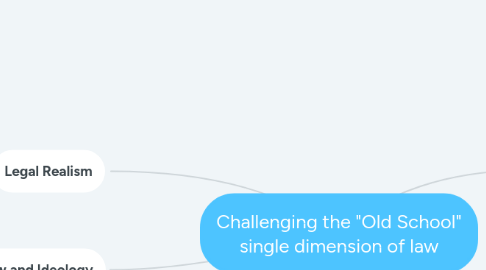
1. Historical School
1.1. German Romantic School
1.1.1. Friedrich Carl von Savigny
1.2. Volksgeist
1.2.1. Spirit of the people
1.2.2. Where the law lies, not law.
1.2.3. Distinct from politics and each other
1.2.4. Underlying reason behind all legal rights
1.2.5. + Jurists=
1.2.5.1. Law becomes more artificial and complex
1.2.5.2. Codification must entail Volksgeist
1.2.5.3. Technical and political element of codification
1.3. Volksrecht
1.3.1. Law emanating from the people
1.3.2. Not necessarily codified or corresponding to positive law
1.3.3. Exists independent of the state
1.4. Custom
1.4.1. Not a source of right but it's indication
1.4.2. =Common, popular, ethical, legal consciousness of people (Kutner)
2. Sociology and Law interplay
2.1. Erlich
2.1.1. Living Law
2.1.1.1. Found in organizations that exhibit inner order
2.1.1.2. Function: Prevent + Settle disputes without resorting to legal institutions of the state
2.1.1.3. Stream example, try to catch and you get a swamp, 1 not all in 2 needs to run
2.1.2. Inner Order
2.1.3. x Positive Law (Legal Provision)
2.1.3.1. Living Law + Inner Order came before, not comparable
2.1.3.2. =Sociological Positivist
2.2. Sociological jurisprudence
2.2.1. N. Roscoe Pound
2.2.1.1. Law in Books v Law in Action
2.2.2. Key points
2.2.2.1. Manifesto of Sociological Jurists
2.2.2.1.1. 1. Effects of Legal Arrangements
2.2.2.1.2. 2. Sociological Surveying in preparation
2.2.2.1.3. 3. Efficacy of Legal Arrangements
2.2.2.1.4. 4. "Sociological" Legal History
2.2.2.1.5. 5. Don't sacrifice fair solutions in the name of certainty
2.2.2.1.6. 6. Procedural Efficiency
2.2.2.2. Interest Theory
2.2.2.2.1. Sociological Jurist must engage in Social interest
2.2.2.3. Jural Postulates
2.2.2.3.1. Mechanism to
2.2.2.4. Social Engineering
2.2.2.4.1. Social control through law (but not indoctrination)
2.2.2.4.2. Lawyers, Jurists, and Lawmakers should engage alike
3. Legal Realism
3.1. American
3.1.1. Law as technology not philosophy
3.1.2. Main people
3.1.2.1. O. Wendel Holmes
3.1.2.2. K. Llewellyn
3.1.3. Main Aspects
3.1.3.1. Address Law to make it better
3.1.3.2. Focus on behavior of legal officials
3.1.3.3. Rule- and Fact- skeptics
3.1.3.4. Mostly lawyers
3.1.3.5. Empiric Scientific Methodology
3.1.3.6. Example: Choice related to food intake
3.1.4. Common points
3.1.4.1. 1. Law is in flux
3.1.4.2. 2. Law is means to a social end, not an end.
3.1.4.3. 3. Society is in flux
3.1.4.4. 4. Need for full separation of "is and ought to" to ensure objectivity
3.1.4.5. 5. Distrust the position that law is actually describing reality, separating precepts and practices.
3.1.4.6. 6. Rationalization in that the traditional descriptive rules should be the favored operative basis for a legal decision
3.1.4.7. 7. Narrowing legal classifications; more categories, more legal species
3.1.4.8. 8. Evaluation of all legal arrangements
3.1.4.9. 9. Sustained and organized attack on the society's legal problems
3.2. Scandinavian
3.2.1. Alf Ross
3.2.1.1. Chess analogy, law as a game
3.2.1.2. No causality between bio-physical acts=> there has to be a reference system to explain everything
3.2.1.3. Introspective Model
3.2.1.3.1. Discover which rules are actually (real-ly) felt
3.2.1.4. Law= what is felt in practice
3.2.1.5. Bridges the gap to law-in-action via logical positivism
3.2.1.6. Everything that is legally meaningful needs to be verified
3.2.2. Carl Olivecrona
3.2.2.1. Law is but 'independent imperatives'
3.2.2.1.1. Legal rules cannot cause legal relations, they can influence people and thus cause human behavior
3.2.2.1.2. =Prescribed action + Imperative Symbol
3.2.2.1.3. Legal language is imperative not descriptive
3.2.3. Axel Hagerstorm
3.2.3.1. Wrong and Right are merely emotive
3.2.3.2. History, rights and duties are hangovers of a primitive society
3.2.3.3. The only reality where law can base in itself is a psychological reality
4. Law and Ideology
4.1. Critical Legal Studies
4.1.1. Critiques the legal Profession, Education, and Adjudication
4.1.2. Main points
4.1.2.1. 1. Law creates social reality
4.1.2.2. 2. A machine to maintain the status quo
4.1.2.3. 3. Law should create a wealth spread society
4.1.3. Roberto Mangabeira Unger
4.1.3.1. Deviationalism ≠ Objectivism
4.1.3.2. Descriptive view of the law
4.1.3.2.1. Customary Primitive
4.1.3.2.2. Bureaucracy as means to keep aristocracy
4.1.3.2.3. Legal Order
4.2. Marxist Jurisprudence
4.2.1. Law= mean to oppress the working class
4.2.2. Superstructure and the basis in law
4.2.3. Marxist Theory of Law
4.2.3.1. Marxist Economism
4.2.3.2. Critique of law in Capitalist society
4.2.3.2.1. Morally and Functionally economic (materialism)
4.3. Feminist Jurisprudence
4.3.1. Law is a feature of the patriarchal system
4.3.1.1. Specific representation of the broader topic of feminism
4.3.2. Descriptive as per status quo but provides also for Normative theory.
4.3.3. Catherine Mackinnon
4.3.3.1. 1. Claim to Objectivism enforces the proliferation of the system
4.3.3.2. 2. State is Male: reflection of gender stereotypes that "Woman" defines social role or submission to men
4.3.3.3. 3. Without Female consciousness there can be no justice.

